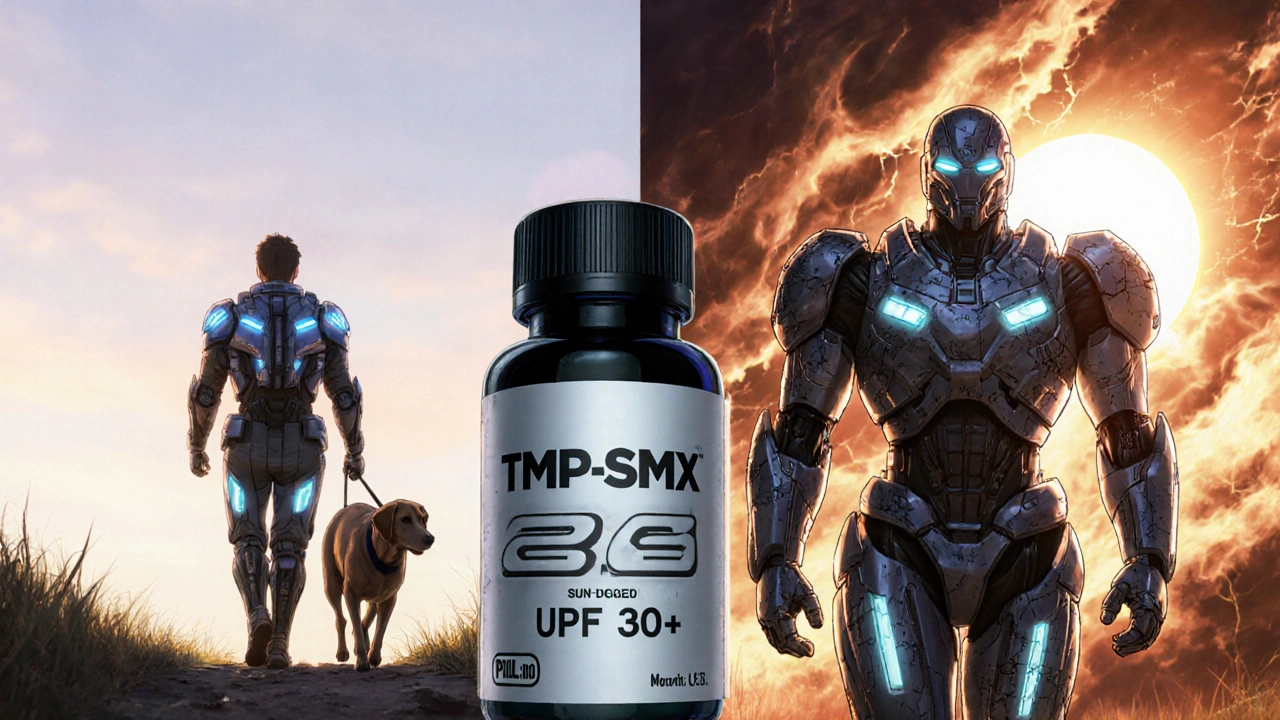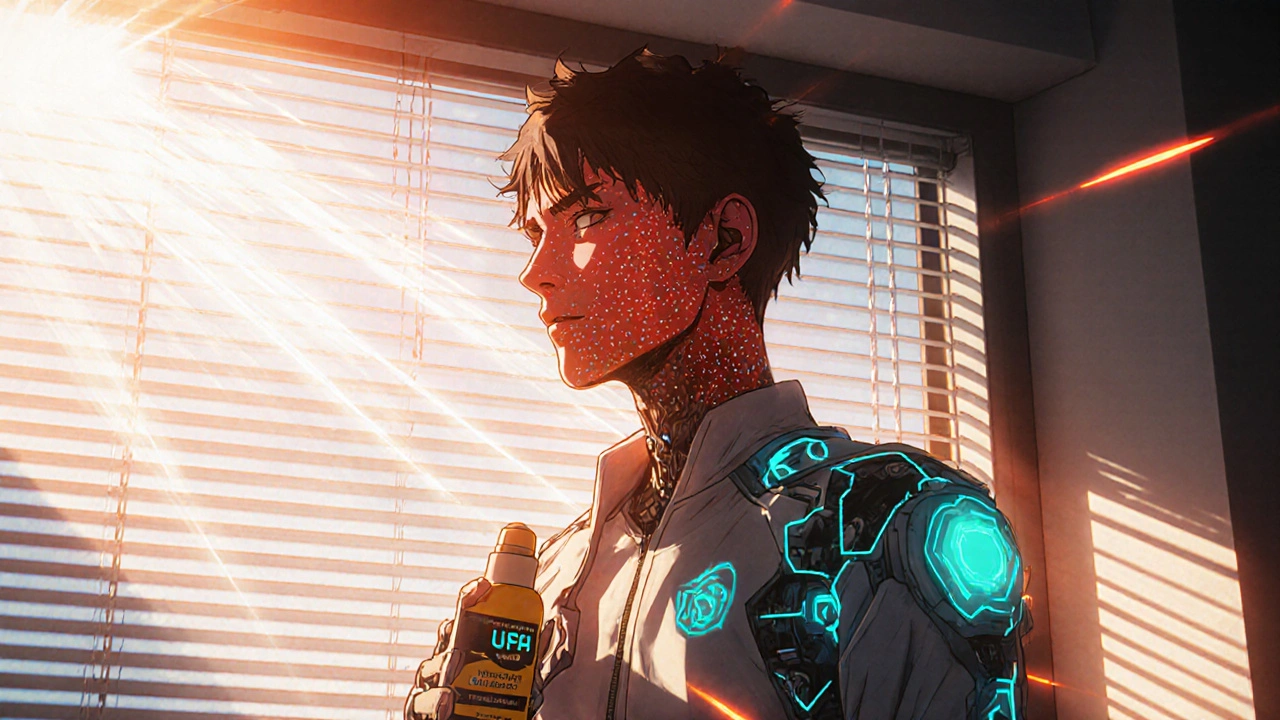Sun Sensitivity Duration Calculator
Sun Protection Calculator
Determine how long you should continue sun protection after stopping your antibiotic
Your Results
Based on medical guidelines and your input
Important: Sun sensitivity can persist for weeks after stopping TMP-SMX. Continue protection until you've fully recovered and your doctor confirms it's safe.
When you’re prescribed doxycycline or TMP-SMX (Bactrim, Septra), your doctor focuses on killing the infection. But there’s another, often overlooked side effect that can turn a sunny day into a painful mistake: photosensitivity. This isn’t just a mild rash-it’s your skin reacting to sunlight like it’s been burned by a flame, even when you’ve only stepped outside for five minutes. And if you don’t know what to look for, you could end up with second-degree burns, blistering, or long-term skin damage-all while taking a medication meant to help you heal.
What Exactly Is Photosensitivity?
Photosensitivity means your skin becomes unusually sensitive to ultraviolet (UV) light because of a drug. It’s not an allergy in the traditional sense. Instead, the antibiotic molecules in your body absorb UV rays, especially UVA (320-400 nm), and trigger chemical reactions that damage your skin cells. This leads to either phototoxic or photoallergic reactions. About 95% of cases are phototoxic-think severe sunburn that shows up fast, within 30 minutes to 24 hours after exposure. The other 5% are photoallergic, which look more like eczema and take a couple of days to appear. Both are painful. Both are preventable.Doxycycline and TMP-SMX are two of the worst offenders. Studies show that up to 20% of people taking doxycycline at standard doses (200 mg daily) will develop a phototoxic reaction. For TMP-SMX, even minimal sun exposure can cause a reaction, and the risk doesn’t disappear when you stop the medication. Some patients report sensitivity lasting weeks after their last pill.
Why Doxycycline and TMP-SMX Are High Risk
Not all antibiotics cause this. Penicillin? Minimal risk. Amoxicillin? Rarely an issue. But tetracyclines like doxycycline and sulfonamides like sulfamethoxazole (the "SMX" in TMP-SMX) are notorious. Why?Doxycycline’s structure absorbs UVA light directly. Once it’s in your skin, that light energy turns into reactive oxygen species-essentially tiny chemical bombs that rupture cell membranes. You don’t need to be at the beach. Sitting near a window at work, driving in the car, or walking the dog at 11 a.m. can be enough. UVA rays penetrate glass, so indoor exposure is a real threat.
TMP-SMX works differently. The sulfamethoxazole component reacts across a broader UV spectrum, and its effects linger. The Skin Cancer Foundation notes that photosensitivity from Bactrim can persist for weeks after you’ve finished the course. That means you can’t just stop wearing sunscreen the day after your last pill. Many patients assume they’re safe once symptoms fade-but they’re not.
How Bad Can It Get?
The damage isn’t just skin-deep. A 1960s study found that 27 out of 108 patients taking demeclocycline (a close cousin of doxycycline) developed severe sunburns within days. All resolved after stopping the drug-but not before causing blistering and peeling. Today, we know that repeated phototoxic reactions increase your lifetime risk of skin cancer. The FDA and Skin Cancer Foundation both warn that drug-induced photosensitivity is a known contributor to premature skin aging and non-melanoma skin cancers.One patient in Leeds, taking doxycycline for a persistent chest infection, got a sunburn through her office window. She thought it was a heat rash. Three days later, her chest was blistering. She went to the ER. Her doctor confirmed it was phototoxicity. She had to stop the antibiotic early, delaying her recovery.

What You Need to Do-Right Now
If you’re on doxycycline or TMP-SMX, treat your skin like it’s made of glass. Here’s what actually works:- Use broad-spectrum SPF 30+ daily-even on cloudy days. Don’t skip your face, neck, ears, or hands. Reapply every two hours if you’re outside.
- Avoid direct sun between 10 a.m. and 4 p.m. That’s when UV intensity peaks. Plan walks, errands, or outdoor time for early morning or late afternoon.
- Wear protective clothing. A regular cotton t-shirt offers only UPF 5-10. You need UPF 30+ rated fabrics-long sleeves, pants, and a wide-brimmed hat. Look for clothing labeled "sun protective."
- Don’t rely on windows. UVA passes through glass. If you sit near a window at home or work, you’re still exposed. Use window films or keep blinds closed during peak hours.
- Keep protecting your skin after finishing the course. For TMP-SMX, continue sun safety for at least two weeks after your last dose. For doxycycline, stop protection only after your doctor says it’s safe-usually within a few days of stopping.
And yes, sunscreen alone isn’t enough. A 2023 study showed that 40% of patients stop using sunscreen within the first week because they forget, think it’s "not that bad," or find it inconvenient. That’s when the worst reactions happen.
What Your Doctor Might Not Tell You
Many healthcare providers assume patients know about sun sensitivity. They don’t. A 2023 review found that nearly half of patients prescribed doxycycline or Bactrim received no verbal warning about sun exposure. Some even got printed leaflets that mentioned it in tiny print under "side effects." That’s not enough.Ask your doctor: "Will this antibiotic make me sensitive to the sun? How long will the risk last after I stop taking it?" If they say "probably not," push back. The FDA, Skin Cancer Foundation, and major dermatology associations all list these two antibiotics as high-risk. This isn’t a gray area-it’s a clear warning.
What About Other Antibiotics?
Not all antibiotics carry this risk. Here’s a quick breakdown:| Antibiotic Class | Examples | Photosensitivity Risk |
|---|---|---|
| Tetracyclines | Doxycycline, Demeclocycline | Very High |
| Sulfonamides | Trimethoprim-Sulfamethoxazole (Bactrim, Septra) | High |
| Fluoroquinolones | Ciprofloxacin, Levofloxacin | Moderate |
| Penicillins | Amoxicillin, Penicillin V | Very Low |
| Cephalosporins | Cephalexin, Cefdinir | Very Low |
Even within the tetracycline class, risk varies. Demeclocycline is worse than doxycycline. Minocycline has a lower risk profile. But unless your doctor tells you otherwise, assume any tetracycline or sulfonamide is high risk.

What to Do If You Get a Reaction
If your skin turns red, burns, blisters, or peels after being in the sun while on one of these antibiotics:- Get out of the sun immediately.
- Cool the area with a damp cloth-no ice, no butter, no aloe vera gel with alcohol.
- Take ibuprofen to reduce inflammation and pain.
- Stay hydrated.
- Call your doctor. You may need to switch antibiotics.
- Do not pop blisters. That increases infection risk.
Severe reactions can lead to scarring or infection. Don’t wait to see if it "goes away on its own."
Why This Matters More Than Ever
Antibiotic use has surged since 2020. More people are on doxycycline for acne, Lyme disease, or respiratory infections. More people are on TMP-SMX for UTIs and pneumonia. At the same time, dermatologists report a 15% year-over-year increase in photosensitivity-related visits since 2018. This isn’t just a minor inconvenience-it’s a growing public health issue.And here’s the kicker: the more we rely on broad-spectrum antibiotics because of rising resistance, the more people will be exposed to these high-risk drugs. Prevention isn’t optional. It’s part of your treatment plan.
Can I still go outside if I’m on doxycycline or Bactrim?
Yes, but you must be extremely careful. Avoid direct sun between 10 a.m. and 4 p.m. Wear UPF 30+ clothing, a wide-brimmed hat, and apply broad-spectrum SPF 30+ sunscreen every two hours. Even sitting near a window can trigger a reaction-UVA rays pass through glass. Short walks early in the morning or late in the evening are safer.
How long does sun sensitivity last after stopping the antibiotic?
For doxycycline, sensitivity usually fades within a few days after stopping. For TMP-SMX (Bactrim), it can last up to two weeks or longer. Some patients report sensitivity for over a month. Don’t assume you’re safe just because you finished your pills. Continue sun protection for at least 14 days after your last dose.
Is SPF 30 enough, or should I use higher?
SPF 30 is the minimum recommended by the FDA and Skin Cancer Foundation. But if you’re fair-skinned, spending extended time outdoors, or on a high-risk drug like doxycycline, SPF 50+ offers better protection. What matters more than the number is consistent reapplication-every two hours, or after sweating or swimming.
Can I use tanning beds while on these antibiotics?
Absolutely not. Tanning beds emit concentrated UVA radiation-exactly the type that triggers phototoxic reactions. Using one while on doxycycline or TMP-SMX can cause severe burns, blistering, and permanent skin damage in minutes. It’s not worth the risk.
Are there any antibiotics that don’t cause sun sensitivity?
Yes. Penicillins like amoxicillin and cephalosporins like cephalexin have very low risk. If you’re concerned about sun exposure, ask your doctor if a lower-risk antibiotic can be used instead. But don’t assume-always confirm. Some patients think "all antibiotics are safe," but that’s not true.

15 Comments
Ross Ruprecht
Ugh, another one of those "don't go outside" articles. I took doxycycline last year and didn't even think about sunscreen. Got a little pink, whatever. I'm not gonna live like a vampire just because some study says so.
Bryson Carroll
Wow this is so dramatic like who even cares if your skin turns red for a day? You're taking antibiotics for an infection not going to Bali. People are so fragile now. I got blistered on Bactrim and just took ibuprofen and kept going. Stop fearmongering
Lisa Lee
This is why Americans are so weak. We used to work in the sun all day and never got sunburned. Now you need SPF 50 UPF 30 hats and window films just to walk to your car. Grow a spine.
Linda Rosie
Thank you for this detailed and necessary reminder. I’ve seen too many patients with phototoxic burns who had no idea this was a risk. Prevention is absolutely part of treatment.
Suzan Wanjiru
I'm a nurse and I see this all the time. Patients think "I'm fine I only stepped out for a minute" and then come in with second degree burns. Seriously just wear the damn hat and reapply sunscreen. It's not that hard
Olanrewaju Jeph
This is brilliant. In Nigeria we don't talk about drug photosensitivity enough. I've seen young men on doxycycline for acne with full chest burns and no idea why. Education saves skin
Pramod Kumar
Bro this hit different. I was on doxycycline for my acne and thought the redness on my neck was just sweat rash. Then one Tuesday I looked like a lobster that got left in the oven. I didn’t even realize I was getting UVA through my window while working from home. Now I wear a shirt indoors. I’m not proud but I’m alive. Also the part about Bactrim lingering? Wild. I stopped it and still burned two weeks later. Nobody told me that.
Don’t let anyone tell you it’s "just a little red." It’s not. It’s your skin screaming. I used to think sunscreen was for beach bums. Now I reapply like I’m guarding a bank vault. And yes I wear a hat to the grocery store. Don’t judge me.
I used to roll my eyes at people who wore long sleeves in 90-degree weather. Now I’m one of them. And I’m not sorry. My skin remembers. I still have the scar on my collarbone. It’s not a fashion statement. It’s a warning label.
And the part about tanning beds? Bro. Just no. That’s not a tan. That’s a crime scene. I’ve seen people come out of those things with peeling like a snake and crying because they thought it was "getting their glow."
Also I didn’t know UVA went through glass. My whole life I thought if I was indoors I was safe. Turns out my desk by the window was basically a UV oven. I’m getting window film installed next week.
Why do doctors assume we all know this? My GP gave me a pamphlet with a footnote. That’s not a warning. That’s a dare.
And to the person who said "just take ibuprofen and keep going" - I hope you never have to explain to your kid why you got melanoma at 38 because you thought "it’s not that bad."
I’m not scared of the sun. I’m scared of ignorance. And this post? It’s the kind of thing that saves lives. Thank you.
Jennifer Shannon
It’s fascinating, really, how we’ve evolved from viewing sunlight as a divine gift - the source of vitamin D, the rhythm of circadian life - to now treating it like a hostile alien force, especially when pharmaceuticals enter the equation. We’ve created a world where medicine, for all its miracles, also introduces invisible vulnerabilities - chemical sensitivities that turn ordinary moments into potential trauma. And yet, isn’t it ironic? We live in an age of unprecedented medical knowledge, yet so many of us still operate on assumptions, on half-remembered advice, on the quiet belief that "it won’t happen to me." But here we are - a society that knows the exact UV index down to the decimal, yet still forgets to reapply sunscreen after five minutes of walking the dog. The paradox is thick: we’re more informed than ever, yet more careless than ever. Maybe the real problem isn’t the antibiotics. Maybe it’s the quiet arrogance of thinking we’re invincible - until our skin starts peeling, and then we’re left wondering how we missed the signs. The truth? We didn’t miss them. We just chose not to see them.
Henrik Stacke
Brilliantly articulated. I’ve been prescribing doxycycline for over 15 years and only recently realized how poorly we communicate this risk. I now have a printed card I hand out - no more tiny print. And yes, I tell patients: "If you’re near a window, you’re exposed." It’s not alarmist. It’s accurate. Thank you for writing this.
Manjistha Roy
I’m from India, and we don’t talk about this enough. My cousin took TMP-SMX for a UTI and got burned while sitting on her balcony in the evening. She thought it was the heat. She didn’t know UVA penetrates clouds. She still has the marks. Please, everyone, share this. This isn’t just Western privilege - this is global health literacy.
Jennifer Skolney
YES. I took doxycycline for my acne and thought I was being careful. Then I got a sunburn on my nose from sitting by the window at work. I cried. I was so mad at myself. Now I wear a hat indoors. I reapply sunscreen like it’s my job. I even bought UPF clothing. It’s weird but worth it. 🙏
JD Mette
I didn’t know about the lingering effect with Bactrim. I stopped the pills and thought I was fine. Then I got sunburned two weeks later. I didn’t connect it until I read this. Thanks for the info. I’ll be more careful next time.
Charmaine Barcelon
You people are ridiculous. You’re acting like this is the end of the world. Just don’t take the medicine if you’re scared of the sun. Problem solved. Stop making everything so dramatic.
Vivian C Martinez
Thank you for the clarity and actionable steps. I’ve shared this with my patients. Many don’t realize that sunscreen alone isn’t enough - clothing and timing matter just as much. This is the kind of guidance that makes a real difference.
Ross Ruprecht
Okay fine I read the whole thing. I guess I was wrong. I’ll wear the hat. But I’m still not buying SPF 50.